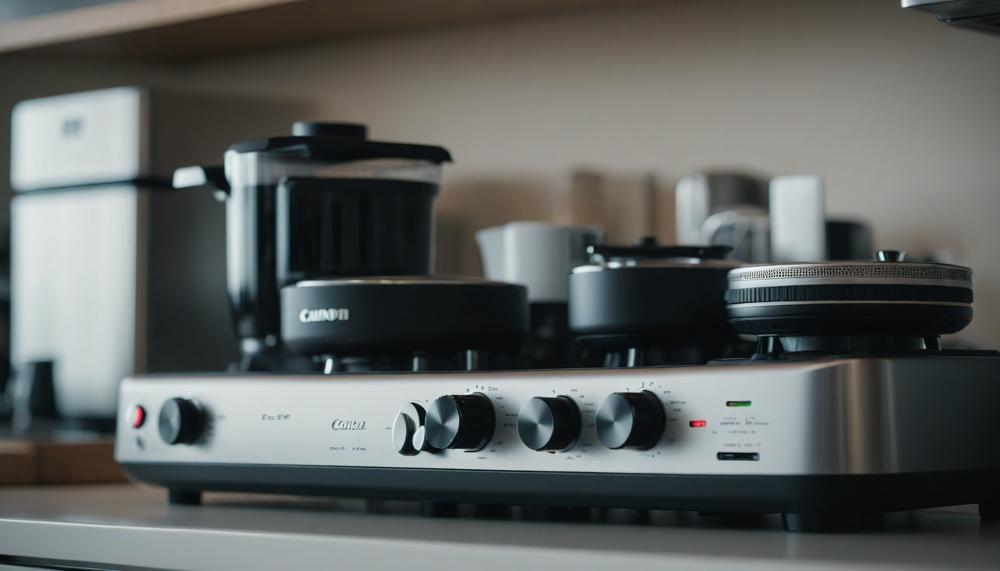Got an old toaster or broken blender gathering dust? Properly disposing of small appliances is more than just clearing up space – it’s a step toward a healthier planet. Tossing these items in the trash can lead to environmental damage and pose risks to sanitation workers. So, what’s the best way to handle them?
First, assess if the appliance still works. If it’s functional, consider donating it to a charity or passing it on to someone in need. For non-working items, recycling is your best bet. Many waste collection companies, recycling centers, and scrapyards accept small electrical appliances. Some retailers even offer recycling programs for old electronics. Remember to always unplug and cool down appliances before disposal.
Key Takeaways:
- Assess Appliance Condition: Donate if functional, recycle if broken.
- Avoid Trash Bins: Regular bins are not suitable for electrical items.
- Find Local Options: Use waste collection companies, recycling centers, or retailers with recycling programs.
- Safety First: Always unplug and let appliances cool down before disposal.
Taking these steps ensures that you’re not only freeing up space but also contributing to a sustainable future. Let’s make a difference by disposing of small appliances responsibly.
Contents
How to Dispose of Small Appliances Properly
You can expect to learn several key aspects about the proper disposal of small appliances from this article. These include:
Environmental Importance
- Understand the significance of disposing of small appliances responsibly to prevent environmental harm.
- Learn how improper disposal can lead to soil and water contamination from harmful substances.
Assessment of Appliance Condition
- Determine whether the appliance is still functional or if it needs to be recycled.
- Explore options for donating working appliances to charities or giving them to friends and family.
Disposal Methods
- Discover various methods for disposing of non-functional small appliances:
- Consulting your city’s waste disposal website for guidelines.
- Utilizing waste collection companies, recycling centers, or scrapyards.
- Taking advantage of retailers’ recycling programs.
Recycling Benefits
- Understand the benefits of recycling small appliances, such as saving money since recyclers typically do not charge a fee.
- Learn about the valuable materials inside small appliances, like gold and copper, that can be recovered and resold.
Safety Measures
- Get tips on safely preparing appliances for disposal, including unplugging them and ensuring they have cooled down.
Recycling Centers and Programs
- Identify the role of recycling centers and the specific programs offered by some retailers to assist in the recycling of small appliances.
Here’s a detailed table summarizing the methods and benefits:
| Method | Details | Benefits |
| Consult City’s Waste Disposal Website | Check for local guidelines and services | Ensures compliance with local regulations |
| Waste Collection Companies | Find companies that accept small electrical appliances | Convenient and often free of charge |
| Recycling Centers | Take appliances to designated recycling facilities | Prevents environmental contamination |
| Scrapyards | Dispose of appliances for material recovery | Recover valuable materials like copper and gold |
| Retailer Programs | Use retailer’s recycling programs | Easy drop-off locations and often part of electronics recycling |
| Donation | Give functioning appliances to charities or friends | Extends the appliance’s lifecycle |
Donate or Sell Your Small Appliances
The benefits of donating or selling small appliances instead of throwing them away are manifold.
| Environmental Impact | Economic Benefits | Social Good |
| Reducing waste is crucial for the environment. Donating or selling small appliances ensures they get a second life, reducing the amount of waste in landfills. This helps to conserve resources and reduce pollution associated with the production of new items. | Selling your small appliances can provide you with extra income or savings. Even older appliances can fetch a reasonable price if they are in good condition, helping you offset costs or save for new purchases. | Donating small appliances supports those in need. Charities like The Salvation Army or Goodwill accept gently used items and often provide pickup services, making it convenient to contribute to a good cause. |
| Resource Conservation | Tax Benefits | Community Support |
| By donating or selling, you help conserve raw materials and energy that would otherwise be used to produce new appliances. This practice promotes a circular economy where items are reused and recycled. | Donating to recognised charities can provide tax deductions. Always ask for a receipt when donating, which you can use to claim deductions during tax season, potentially saving you money. | Supporting local charities and non-profits strengthens community bonds. Your contributions help these organisations provide essential services and support to those who are less fortunate, fostering a sense of community well-being. |
| Minimal Effort | Decluttering | Creating Opportunities |
| Many charities offer convenient pickup services, meaning you don’t even have to leave your home. Selling online through platforms like eBay or Gumtree is straightforward and can be done from the comfort of your living room. | Getting rid of unused appliances declutters your home, creating more space and reducing stress associated with clutter. A tidy home can contribute to a more peaceful and organised living environment. | Donated items often end up in second-hand stores, providing affordable options for others. This not only helps people save money but also creates jobs within the community for those working in these stores or associated programs. |
We Recommend
The best practices for disposing of small appliances in a way that is both environmentally friendly and safe for households are outlined below. Following these steps ensures minimal environmental impact and maximizes safety.
Assess the Condition
First, determine if the appliance is functional or not.
- Functional Appliances: Consider donating or selling.
- Non-functional Appliances: Prepare for recycling or safe disposal.
Safe Disposal Practices
- Unplug the Appliance: Ensure it has been unplugged and not in use for several days to avoid electrical hazards.
- Remove Hazardous Parts: Batteries and other hazardous components should be removed and disposed of properly.
Recycling Options
Recycling is the preferred method for non-functional appliances.
| Method | Description | Details |
| Specialized Recycling Centers | Take appliances to centers that specialize in electronic waste. | Find local centers through Earth911 or municipal websites. |
| Retailer Recycling Programs | Utilize recycling programs offered by electronics retailers. | Check programs at stores like Best Buy or local hardware stores. |
| Electronic Waste Collection Events | Participate in city-organized events for collecting e-waste. | Look for announcements on city websites or community boards. |
| Scrapyards | Give non-functional appliances to scrapyards. | Contact local scrapyards to see if they accept small appliances. |
Donation and Reuse
For functional appliances, consider these options:
| Method | Description | Details |
| Donation | Donate to charities or non-profit organizations. | Organizations like Goodwill or local shelters. |
| Sell | Sell through online marketplaces or garage sales. | Platforms like eBay, Craigslist, or local community groups. |
Avoid Trash Disposal
Throwing appliances in the trash harms the environment and endangers workers.
- Environmental Impact: Small appliances contain metals and plastics that do not decompose and can release toxins.
- Worker Safety: Disposed appliances can cause injuries during handling and processing.
Reduce, Reuse, Recycle
Reducing, reusing, and recycling are fundamental strategies for the proper disposal of small appliances, significantly minimising environmental impact and promoting sustainability.
Reducing
By reducing the number of small appliances purchased and used, less waste is generated. Opt for energy-efficient appliances with longer lifespans, and focus on repairing and maintaining existing appliances instead of replacing them frequently.

This not only cuts down on waste but also conserves resources used in manufacturing.
| Method | Description | Benefits |
| Reducing | Buy fewer appliances and choose long-lasting, energy-efficient models. | Less waste, conservation of resources, and reduced environmental impact. |
Reusing
Reusing involves finding new purposes for old appliances, delaying their entry into the waste stream. An old appliance can be repurposed creatively, such as turning a broken microwave into a storage container or using an old coffee maker as a flower pot. This approach saves money and reduces the need for new products.
| Method | Description | Benefits |
| Reusing | Repurpose old appliances for new uses. | Reduces waste and saves money. |
Recycling
Recycling small appliances involves breaking them down into their basic materials and reusing these materials to create new products. This process significantly reduces the volume of waste sent to landfills and lessens the need for new raw materials, which in turn saves energy and reduces carbon emissions.
Proper recycling requires specialised facilities to handle hazardous materials like lead, mercury, and cadmium found in many appliances. Manufacturers and retailers often offer recycling programs or trade-in options, making it convenient for consumers to dispose of appliances responsibly. For example, many companies provide drop-off or mail-in services to ensure safe recycling.
| Method | Description | Benefits |
| Recycling | Break down appliances into raw materials for reuse. | Reduces landfill waste, conserves natural resources, and saves energy. |
Environmental and Health Benefits
Proper disposal of small appliances through these methods reduces the risk of hazardous materials contaminating soil and water, protecting both human health and the environment. For instance, safely recycling components prevents harmful substances from leaching into ecosystems.
Additionally, reducing and reusing cut down the demand for new products, conserving natural resources and lowering greenhouse gas emissions from production processes.
Conclusion
Properly disposing of small appliances is more than just a way to clear space—it’s a crucial step towards environmental stewardship. Simply tossing old toasters or broken blenders in the trash can lead to significant environmental harm and pose risks to sanitation workers. Here’s how to handle these items responsibly:
First, evaluate if the appliance still works. If it does, consider donating it to a charity or passing it on to someone in need. This not only helps others but extends the appliance’s useful life. If the appliance is broken, recycling is the best option. Many waste collection companies, recycling centers, and even retailers offer programs to recycle small electrical appliances.
Remember, regular trash bins are unsuitable for these items due to the potential release of harmful substances. Always unplug and cool down appliances before disposal to ensure safety.
By choosing to recycle, you contribute to the recovery of valuable materials like gold and copper, reducing the need for new raw materials. This not only conserves resources but also minimizes the environmental impact of mining activities.
In summary, assess, donate if possible, and recycle if necessary. This approach not only helps you declutter but also supports a sustainable future.





